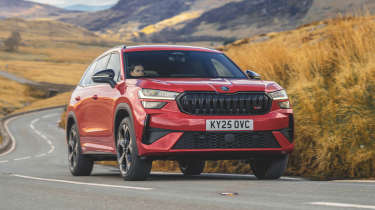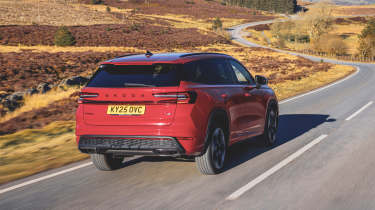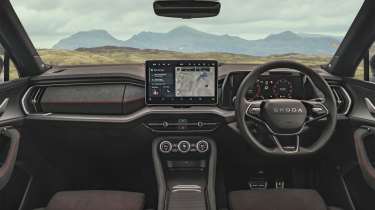Skoda Kodiaq vRS 2025 review – a seven-seat Golf GTI?
Skoda’s second-gen Kodiaq has been given the vRS treatment, which includes a 261bhp Golf GTI engine. But can a sensible, seven-seat Skoda be fun?
The new Skoda Kodiaq vRS has many bases to cover. Some would say too many. On the one hand, it needs to be a competent all-round family bus with space for seven, and the kind of no-nonsense, thoughtful approach that makes ordinary Skodas appealing. But it also has a Golf GTI engine, a beefy bodykit and, in Skoda’s words, ‘a chassis designed to appeal to driving enthusiasts’. That’s quite a lot for one car to do, and Skoda is charging a fair amount for it, with the vRS costing £53,690 – over £15k more than the base Kodiaq.
The vRS isn’t as garish or offensive as some juiced up performance SUVs, but you wouldn’t call it a looker. It’s bluff, slab sided and relatively long at 4.7 metres, to make room for three rows of seats. Climb inside and the cabin is much more interesting than the usual drab architecture you’ll find in a modern Volkswagen. There’s alcantara trim, ambient lighting strips across the dash and doors and a pair of racy looking sports seats up front. But don’t expect a remotely sporty driving position – a big SUV is never going to feel low slung but you sit especially high in the Kodiaq, the wheel set too far away and low down, too.
Behind the wheel there’s a digital instrument pack, and across from that a large 13-inch touchscreen bolted to the dash. The graphics are crisp and it's relatively easy to use, and unlike in modern Volkswagens, there are physical dials below the screen – Smart Dials as Skoda calls them. They bundle multiple controls, such as temperature, media volume and drive mode selection into three dials with switchable displays. A clever idea, but in practice, cycling through the various functions to find the one you want feels like an unnecessary step.
Set off with the powertrain and suspension backed off and you’ll wonder whether you did in fact stump up the extra cash for the vRS. The Kodiaq is very easy going, the body control free and relaxed over bumps and the engine whirring away without an especially sporty note. It’s the same 2-litre EA888 lump you’ll find in the latest Octavia vRS and Golf GTI, generating 261bhp and 295lb ft of torque, but in the 1903kg Kodiaq it has not far off half a ton more to lug around. Switch up to Sport and it takes on a bassy but slightly annoying, drony sound and still doesn’t give the Kodiaq the feel of a jumbo hot hatch. It’s brisk but never feels especially quick or vRS-like. The seven-speed DSG gearbox shifts through ratios swiftly but can be reluctant on the way down (the gearing means there sometimes aren’t enough spare revs for a downshift, when you expect there to be). There’s very little satisfaction in working the engine hard, so you tend to sit back, leave the paddles alone and settle into a measured pace.
At these lower speeds it’s hard to find a sweet spot in the Kodiaq’s drive modes. The relaxed body control initially gives the impression of a pillowy ride, and though it is absorbent over big bumps, the Kodiaq struggles over sharp imperfections, which sometimes jolt through the car. Dialling the standard-fit DCC dampers back to the softest of their 15 settings doesn’t iron out these sharper edges and instead introduces too much floatiness through undulations; setting it between Comfort and Sport is a better compromise. So configured, you can cover miles in the vRS effortlessly, only the odd pothole or expansion joint disturbing the flow.
Hurling a seven-seater along a twisting road is never going to feel natural, but the Kodiaq doesn’t completely unravel, particularly when in Sport mode. This ties the body down and adds reassuring weight to the steering, and it’s possible to hustle the vRS and find a nice flow with it. It’s stable with decent grip to lean on, and traction from the four-wheel drive system is pretty much absolute. The flip side is that there’s no spark or sense of connection to the way the Kodiaq drives, and very little in the way of adjustability. It does pretty much the same thing through every corner, every time, following your commands but offering very little satisfaction. It’s not long before you back off, relax and start driving it normally, as you would an ordinary Kodiaq.
And that’s precisely where the vRS falls down. It’s not particularly hot and doesn’t have the amusement factor of the best big, fast SUVs, and is therefore hard to justify over a standard Kodiaq. Better to get one of those if you need a competent seven-seater, and spend the cash you’ll save on something that’s genuinely fun.
Price and rivals
The vRS’s closest competitor comes from Skoda’s parent company, with the Volkswagen Tayron offered with the same 2-litre 261bhp engine in R-Line trim. So equipped, it’s a little cheaper than the Kodiaq at £52,320. Cupra’s Terramar, meanwhile, offers the same powertrain in a smaller SUV package for £46,745. For something smaller again but significantly more racy, Mercedes-AMG offers the GLA 35 for two grand more than the Skoda.
A variety of fast estates can also be had for the same money or less. Skoda’s own Octavia vRS is much more satisfying to drive than the Kodiaq and significantly cheaper at £41,070, and the same goes for Cupra’s Leon estate in 328bhp VZ1 spec, which comes in at £47,000. If you want to step up to something more premium, but not as sporting, BMW’s 5-series Touring costs £54,445 in 520i form.




